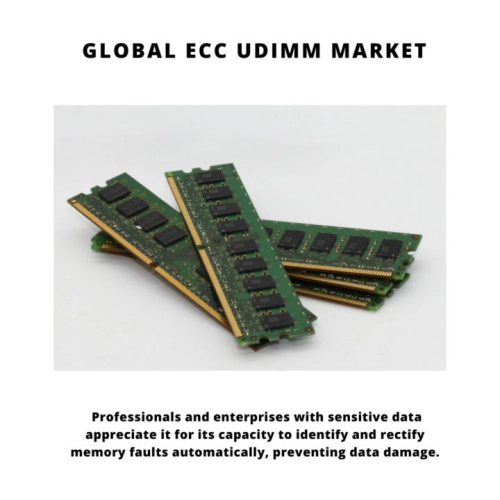
- Get in Touch with Us

Last Updated: Apr 25, 2025 | Study Period: 2024-2030
ECC memory is a form of RAM memory that may be found in workstations and servers. Professionals and enterprises with sensitive data appreciate it for its capacity to identify and rectify memory faults automatically, preventing data damage.

It's also said to result in fewer server/workstation failures when compared to non-ECC memory, making it very tempting to IT professionals and enterprises, such as financial institutions and public cloud service providers, where data corruption and outages are major problems.
Because ECC memory is designed for corporate workloads, most consumer PC motherboards either don't support it or operate it without the ECC feature. You'll need a workstation/server level motherboard to get the benefits of ECC memory.
The Global ECC UDIMM Market accounted for $XX Billion in 2023 and is anticipated to reach $XX Billion by 2029, registering a CAGR of XX% from 2024 to 2030.
The debut of Innodisk's new industrial-grade DDR5 memory in workstations, which are powerful machines designed for specialised technical and scientific use cases, has been announced.
Early adopters will be able to demonstrate the real-world speed and performance benefits that were promised during the hoopla around the announcement by bringing this new technology to market immediately.
For their workstation machines, they used Innodisk's 4800MT/s 32GB DDR5 UDIMM.
These workstations are perfect for early DDR5 adoption because they deliver server-grade performance in a conventional PC form size, with high-end CPUs and enough memory for CPU and RAM-intensive tasks like graphics, 3D design, and video editing.
DDR5's innovative technologies, including double bank groups, same bank refresh, on-die ECC, and dual subchannels, are already being used in workstations that push the limits of speed, capacity, and reliability in professional contexts, as Innodisk starts mass production.
| Sl no | Topic |
| 1 | Market Segmentation |
| 2 | Scope of the report |
| 3 | Abbreviations |
| 4 | Research Methodology |
| 5 | Executive Summary |
| 6 | Introduction |
| 7 | Insights from Industry stakeholders |
| 8 | Cost breakdown of Product by sub-components and average profit margin |
| 9 | Disruptive innovation in the Industry |
| 10 | Technology trends in the Industry |
| 11 | Consumer trends in the industry |
| 12 | Recent Production Milestones |
| 13 | Component Manufacturing in US, EU and China |
| 14 | COVID-19 impact on overall market |
| 15 | COVID-19 impact on Production of components |
| 16 | COVID-19 impact on Point of sale |
| 17 | Market Segmentation, Dynamics and Forecast by Geography, 2024-2030 |
| 18 | Market Segmentation, Dynamics and Forecast by Product Type, 2024-2030 |
| 19 | Market Segmentation, Dynamics and Forecast by Application, 2024-2030 |
| 20 | Market Segmentation, Dynamics and Forecast by End use, 2024-2030 |
| 21 | Product installation rate by OEM, 2023 |
| 22 | Incline/Decline in Average B-2-B selling price in past 5 years |
| 23 | Competition from substitute products |
| 24 | Gross margin and average profitability of suppliers |
| 25 | New product development in past 12 months |
| 26 | M&A in past 12 months |
| 27 | Growth strategy of leading players |
| 28 | Market share of vendors, 2023 |
| 29 | Company Profiles |
| 30 | Unmet needs and opportunity for new suppliers |
| 31 | Conclusion |
| 32 | Appendix |